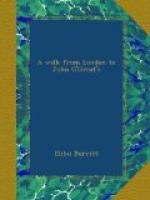“At the Battersea Show last year, my attention was called to some enormous ears of wheat, which I thought could not have been grown in England. For, although the British farmer can grow corn with anyone, I had never seen such wheat here, and thought it must be foreign wheat. I went to the person who was threshing some out, and having been informed that it was sown only with one seed in a hole, I procured some of Mr. Hallett, of Brighton; and, being anxious to try the system, I planted it according to Mr. Hallett’s directions— one grain in a hole, the holes nine and a half inches apart, with six inches between the rows. To satisfy myself on the subject, I also planted some according to Stephen’s instructions, who said three grains in a hole would produce the most profitable return. I also planted some two grains in a hole. I sowed the grain at the end of last September, on bad land, over an old quarry, and except some stiff clay at the bottom of it, there was nothing in it good for wheat. The other day I counted the stalks of all three. On Mr. Stephen’s plan of three grains in a hole, there were eighteen stalks; with two grains in a hole, there was about the same number; but with one seed in a hole, the lowest number of stalks was sixteen, and the highest twenty-two. I planted only about half an acre as a trial, and when I left home a few days since, it looked as much like eight quarters (sixty-four bushels) to the acre as any I have seen. The ears are something enormous. I would certainly recommend every farmer to make his own experiments, for if it succeeds, it will prove a great economy of seed; and drills to distribute it fairly are to be had.”
Truly one of Hallett’s wheat ears might displace the old cornucopia in that picture of happy abundance so familiar to old and young. Here are twenty ears from one seed, containing probably a thousand grains. The increase of a thousand-fold, or half that ratio, is prodigious, having nothing to equal it in the vegetable world that we know of. If one bushel of seed wheat could be so distributed by a drill as to produce 500 or 250 bushels at the harvest, certainly the staff of life would be greatly cheapened to the millions who lean upon it alone for subsistence.
From Oundle I walked the next day to Stamford, a good, solid, old English town, sitting on the corners of three counties, and on three layers of history, Saxon, Dane and Norman. The first object of interest was a stone bridge over the Nen at Oundle. It is a grand structure to span such a little river. It must have cost three times as much as “The Great Bridge” over the Connecticut at Hartford; and yet the stream it crosses is a mere rivulet compared with our New England river. “The bridge with wooden piers” is a fabric of fancy to most English people. They have read of such a thing in Longfellow’s poems, but hardly realise that it exists still in civilised countries. Here bridges are works of art as well as of utility, and rank next to the grand old cathedrals and parish churches for solidity and symmetry. Their stone arches are frequently turned with a grace as fine as any in St. Paul’s, and their balustrades and butments often approach the domain of sculpture.




